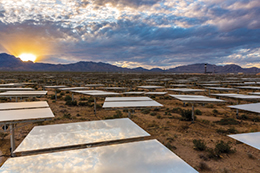
California's Solar Gold Rush
Five years ago, Fresno, Calif., Local 100 was in deep trouble.
"We were looking at Depression-era unemployment, 35-40 percent of our 800 members were on the bench and most of the ones working weren't seeing a full 40 hours in a week. We lost more than 100 members," said Local 100 Business Manager Kevin Cole. "The economy around here was devastated. Solar saved this local."
In the last two years, Cole said, total hours worked are nearly back to pre-recession levels and solar projects have accounted for nearly 80 percent.
Across Southern California, grid-scale solar projects — those larger than 50 megawatts, often much larger — have been going up at an unprecedented rate, buoying the fortunes of nearly a dozen construction locals. The state now has enough solar capacity installed to power more than 2.25 million homes, nearly all of it built in the 10 counties south of San Luis Obispo in the last three years.
The abundant sunshine and thousands of square miles of desert range have held out promise since photovoltaics were first commercialized 40 years ago, but three forces have come together to bring that promise to fruition. First, the price of solar panels has been falling rapidly: more than 75 percent since 2006. Second, the 30 percent federal investment tax credit that debuted in 2006 and was extended in 2008, provided an automatic, reliable incentive that made multibillion dollar solar projects more attractive to lenders and investors.
Finally, in 2011, Gov. Jerry Brown assigned an expansion of California's renewable portfolio standard, increasing the amount of energy the state's utilities had to source from solar, wind, geothermal or hydroelectric from 20 to 33 percent by the year 2020. The state's utilities went on a buying spree, locking in decades-long power purchasing agreements with solar developers at fixed prices, removing a great deal of risk for developers and investors.
"The IBEW up and down the state had a large presence in Sacramento advocating for the RPS expansion," said San Diego Local 569 Business Manager Johnny Simpson. "I won't say it wouldn't have passed without us, but we worked very hard to get it done and I think it has paid off for the state and for our members." 
|
 Print
Print  Email
Email
